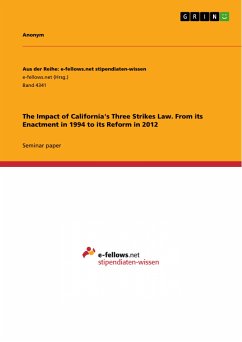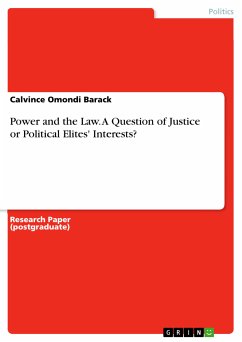Seminar paper from the year 2023 in the subject Politics - Region: USA, grade: 1,3, San Diego State University, course: Seminar Democracy in America, language: English, abstract: This paper examines the consequences of both the original TSL and its reform, focusing on the key question of to what degree the reform was able to rectify the flaws of the initial ruling. To achieve this, the first part of the paper describes the context in which the law was initially developed and enacted. Subsequently, the original application in the second and third cases is explained before outlining the alterations introduced by the Reform Act in 2012. The paper will discuss the original TSL, concentrating on four major points of criticism. First, the effectivity of the law in reducing high crime rates in CA and the accuracy of the implementation of the voters will. Furthermore, the life-changing consequences for the convicts and their families and the enormous economic costs for the state's justice and prison system associated with the higher number of people serving lengthy prison sentences. The paper will end with a conclusion that summarizes the key points and answers the key question. The genesis and passage of California's so-called "Three Strikes Law" (TSL) occurred against the backdrop of the highest crime rate in the state's history. However, it was two homicides of young American girls that shocked the Californian people, sparking a public outcry and compelling lawmakers to finally take more decisive measures. The result was the enactment of California's Three Strikes Law in 1994, which was neither the first nor the only such law but by far the strictest in the entire nation. Its enactment, marking the most significant change to the Californian criminal justice system in more than a generation, aimed to better protect the public from habitual criminals who commit violent and other serious felonies. The new law would have sentenced them to prison for 25 years to life. However, it also led to the lengthy incarceration of many non-violent second and third strikers, prompting criticism of disproportionately harsh punishment. After several unsuccessful attempts, the "Three Strikes Reform Act" (TSRA) was passed in 2012, significantly reforming the TSL by restricting its application to repeat serious and violent offenders, aligning with the original intention of Californian voters and lawmakers.
Dieser Download kann aus rechtlichen Gründen nur mit Rechnungsadresse in A, B, BG, CY, CZ, D, DK, EW, E, FIN, F, GR, HR, H, IRL, I, LT, L, LR, M, NL, PL, P, R, S, SLO, SK ausgeliefert werden.









